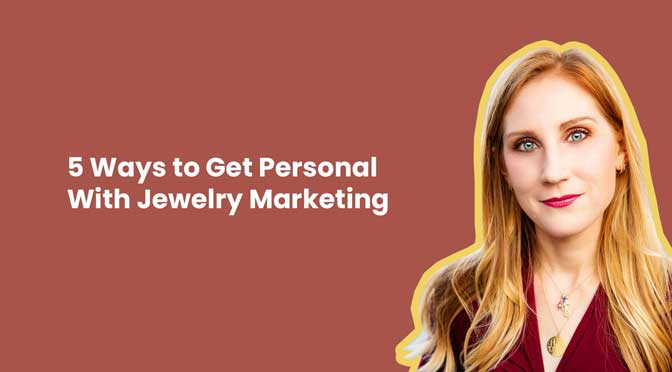5 Ways to Get Personal With Jewelry Marketing
In our recent blog post “Jewelry Marketing for a Post-COVID-19 Future“, we emphasized the fact that customer experience will need to remain at the center of all your jewelry marketing efforts in 2020 and for the foreseeable future. One of the most effective ways to improve customer experience is to be personal with your marketing and outreach. In this blog post, we’ll share five ways you can do that.
First, you’ll want to know why personalization is so impactful. Did you know that 80% of consumers are more likely to make a purchase from a brand that provides personalized experiences (Source)? In fact, 83% crave a personalized experience so intensely that they’ll share data to get it (Source).
If you’re not making at least some effort to be more personal with your jewelry marketing efforts, then you’re alienating your customers. Segmenting and personalizing email campaigns, reaching out to VIP customers, leveraging your data and insights, refining your ads, and offering product recommendations are five of the most impactful ways to be personal.
Segment and personalize email campaigns
Email marketing promises to be one of the most personalized forms of digital marketing, since you already have a direct way to contact the individual consumer through her email address, which she has given you permission to use. By gathering as much information as you can in your email signup form, you’ll have more lead data, which will allow you to segment your campaigns and make them more relevant. For example, you can segment your master list by age, geographic location, and purchase interests.
Furthermore, if you gather email addresses at a live event instead of on your website, then you can add those contacts to a specific segment. In addition, you can use customer behavior to personalize your email campaigns; examples of behavior include past purchases, purchase frequency, purchase cycle, email engagement level, changes in purchase behavior, and more. It can take some time and effort to set up various emails for different segments, but you’ll end up with more targeted and impactful email campaigns.
Reach out to VIP customers
Did you know that it costs five times more to acquire a new customer than it does to retain an existing customer (Source)? If you have a limited marketing budget right now, then you’ll definitely get more value by focusing the bulk of your time and effort on retention instead of acquisition. Reaching out to your VIP customers is an excellent way to get personal and specific.
Who are the customers who spent the most money with you last year or over the past five years? Draft an email or even a traditional letter (if you have customers’ mailing addresses) and then take the time to make it personal. Explain to each individual why she’s such a valued client and describe why you enjoyed working with her in the past. Make some personalized recommendations or offer extra value. Your most loyal customers will recognize your efforts and appreciate them – at the end of the day, they’ll be more likely to buy again and again.
Leverage data and insights
Plain and simple: you can’t personalize your marketing efforts if you don’t know what you customers want. Do you often find that your marketing outreach and promotions fall flat with customers? You may think you’re offering a great deal, but you’re also not your customer. Stop deciding what your customers want and start listening to them.
To do this, you can survey your prospective and current customers. In addition, you can use all the data you have available: from Google Analytics, Facebook Insights, Instagram Insights, and more. Once you can clearly map out your consumers’ shopping habits and path to purchase, then you’ll be able to use that information to help you make decisions about future marketing initiatives.
Refine your ads
One of the coolest things about running ads today, especially if you’re running Facebook or Instagram ads, is that you can get hyper-specific with your targeting. Not only can you target shoppers who have visited your website in the past or who have signed up for your email campaigns, but you can also target shoppers by demographics, interests, and behaviors. Use that targeting to your advantage!
Don’t deliver the same exact ad to every type of customer you’re trying to target. Instead, create multiple ads with different photos and captions and then decide which combination of the two will appeal to each type of customer. The ads will feel more personalized and relevant. In addition, you can try Facebook’s dynamic product retargeting ads, which show customers products they’ve already viewed on your ecommerce store.
Offer product recommendations
Did you know that 91% of consumers say they’re more likely to shop with brands that provide relevant offers and recommendations (Source)? To offer your customers product recommendations, you’ll want to know about recommendation engines, which are tools that analyze data about both your products and your users. The three types of recommendation engines include: collaborative filtering systems, content-based filtering systems, and hybrid recommendation systems. While collaborative filtering systems analyze data about multiple customers, content-based filtering systems look at a customer’s past choices, and hybrid systems do both. We recommend researching some recommendation systems and finding a solution that works best for your needs.
Blockchain expert Julian Hillebrand summarizes the importance of personalization best: “Personalized marketing and advertising is not about sales. It’s about building a relationship with the customer.” Personalized marketing tactics should never be viewed as manipulation tactics; instead they must support the entire customer experience and build loyalty and trust with the customers who matter.

